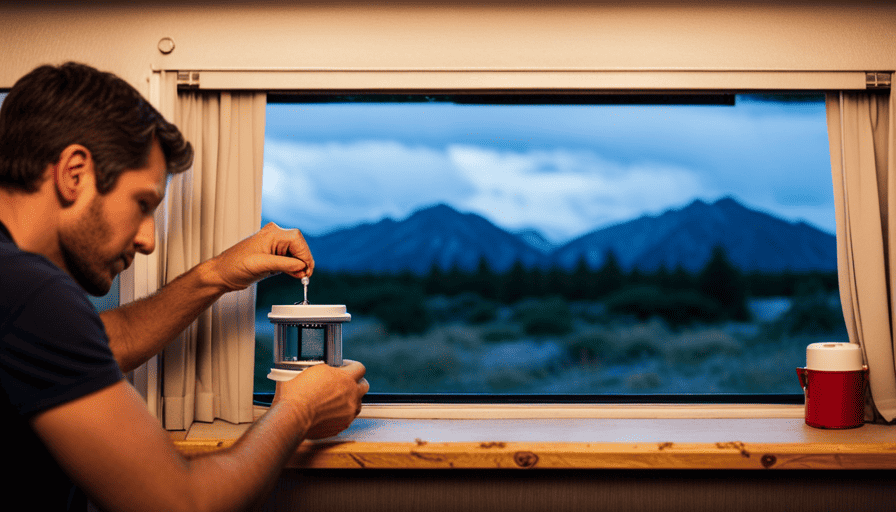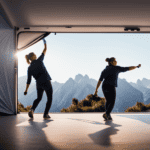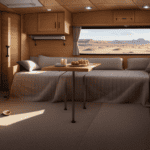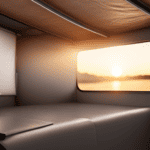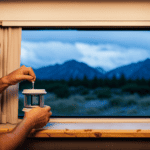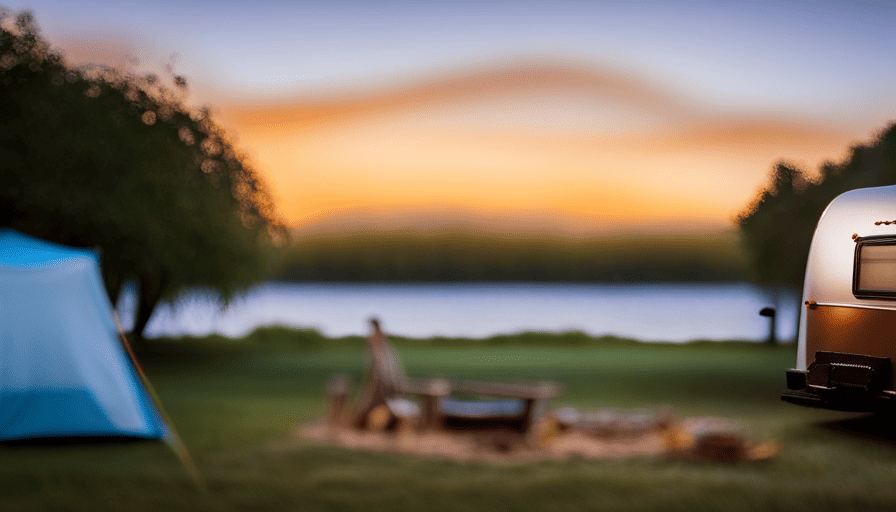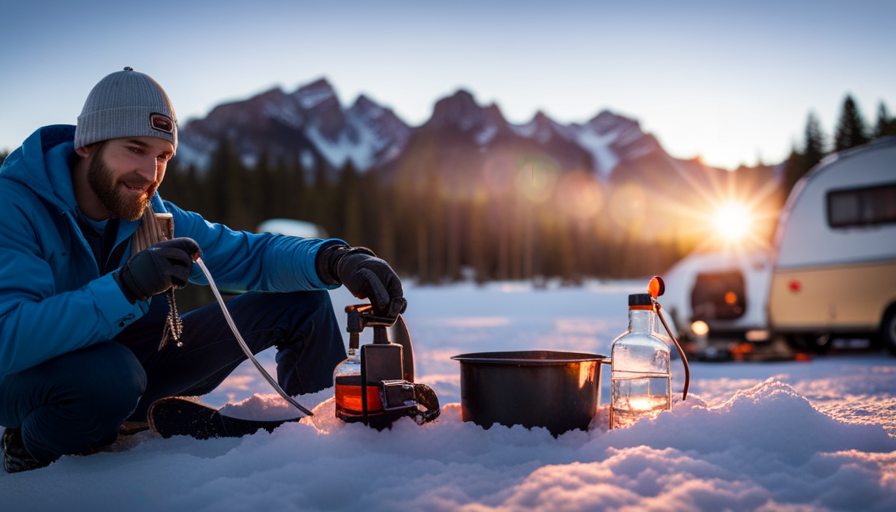Do you find it frustrating when your toes feel like ice cubes in your camper during cold nights? Well, fret not! I have the ideal solution for you.
In this article, I will show you the step-by-step process of insulating the bottom of your camper to keep it warm and cozy all year round. We’ll start by assessing your camper’s current insulation and determining the best material for the job. Then, we’ll prepare the bottom surface, seal any gaps or cracks, and install insulation boards or panels.
I’ll also guide you through insulating your plumbing and electrical systems for added protection. Once the insulation is in place, we’ll cover it with a protective layer and test for any air leaks that may need adjusting.
So, get ready to snug up in your camper and enjoy the great outdoors, no matter what the temperature is outside. Let’s get started!
Key Takeaways
- Assess current insulation to determine if improvements are needed.
- Choose the right insulation material: fiberglass, foam board, or spray foam.
- Ensure insulation material fits tightly and covers all areas without gaps.
- Properly insulate plumbing and electrical systems to protect them.
Assess Your Camper’s Current Insulation
Before you begin insulating the bottom of your camper, it’s essential to assess the current state of its insulation. Inspecting the existing insulation will give you a clear idea of its efficiency and help you determine if any improvements need to be made.
Start by visually inspecting the underside of your camper. Look for any signs of damage, such as tears or gaps in the insulation. Pay close attention to areas where the insulation may have worn thin or become dislodged.
Next, check for any moisture or mold growth, as this can indicate poor insulation. Moisture can seep through cracks and compromise the effectiveness of the insulation. If you notice any issues, it’s important to address them before proceeding with the insulation project.
Improving insulation efficiency is crucial for maintaining a comfortable interior temperature in your camper. It helps keep the cold air out during winter camping trips and prevents excessive heat from entering during the summer months. By assessing the current state of your camper’s insulation, you’ll be able to identify areas that require attention and improve the overall insulation efficiency.
Now that you’ve inspected the existing insulation, it’s time to choose the right insulation material for your camper’s bottom.
Choose the Right Insulation Material
First, imagine yourself nestled snugly in your cozy home on wheels, protected from the outside world by a layer of insulation that feels like a warm embrace. When it comes to insulating the bottom of your camper, choosing the right insulation material is crucial.
There are several types of insulation to consider, each with its own benefits and drawbacks. Some common insulation types include fiberglass, foam board, and spray foam. Fiberglass insulation is affordable and easy to install, but it may not provide the best thermal performance. Foam board insulation offers excellent insulation properties and is resistant to moisture, but it can be more expensive. Spray foam insulation provides an airtight seal and superior thermal performance, but it requires professional installation.
When installing insulation in your camper, there are a few tips to keep in mind. First, ensure that the insulation material fits tightly and covers all areas, leaving no gaps for air or moisture to penetrate. Additionally, consider using insulation with a high R-value, which indicates its thermal resistance. Lastly, follow the manufacturer’s instructions for proper installation techniques and safety precautions.
To prepare the bottom surface for insulation, it’s important to clean and remove any debris or obstructions. By doing so, you’ll create a smooth and even surface for the insulation to adhere to.
Prepare the Bottom Surface
Once you’ve cleared away any debris or obstructions, make sure to thoroughly clean the surface beneath your cozy home on wheels, creating a smooth and even foundation for the insulation material to securely adhere to. Preparing the surface is an essential step in the process of insulating the bottom of your camper.
To start, sweep away any dirt, dust, or loose particles using a broom or brush. Next, use a vacuum cleaner to remove any remaining small debris. After that, wash the surface with a mild detergent and water solution, using a scrub brush to remove any stubborn stains or grime. Rinse thoroughly and allow the surface to dry completely before proceeding with the insulation installation. It’s important to note that any dirt or residue left on the surface can compromise the effectiveness and adhesion of the insulation material.
Once the surface is clean and dry, you can move on to the next step of sealing any gaps or cracks, ensuring a well-insulated and energy-efficient camper.
Seal Any Gaps or Cracks
To ensure a well-sealed and energy-efficient space, make sure to check for any gaps or cracks in your cozy home on wheels. Even a small opening can significantly impact insulation effectiveness. Did you know that just a 1/8-inch gap around a window can let in as much air as having a 2.4-inch hole in the wall?
To fix cracks and seal gaps, start by thoroughly inspecting the bottom surface of your camper. Look for any visible cracks or openings where air might escape or enter. Common areas to check include the seams between the floor and walls, around windows and doors, and where utility connections enter the camper.
Once you’ve identified these problem areas, it’s time to take action. Begin by cleaning the surfaces around the cracks or gaps to ensure proper adhesion. Use a brush or vacuum to remove any dirt or debris that may interfere with the sealing process.
Next, choose an appropriate sealant for the job. There are various options available, such as silicone caulk or expanding foam. Apply the sealant generously to the cracks or gaps, making sure to fill them completely. Smooth out the sealant with a putty knife or your finger to create a uniform and watertight seal.
By fixing cracks and sealing gaps, you can prevent unwanted air leaks and improve the overall insulation of your camper. Now that you’ve sealed any gaps or cracks, let’s move on to the next step: installing insulation boards or panels.
Install Insulation Boards or Panels
Now that you’ve sealed any gaps or cracks, it’s time to amp up the coziness by installing insulation boards or panels in your home on wheels!
Insulating the bottom of your camper is crucial to maintain a comfortable temperature inside and prevent any heat loss or gain. There are various insulation types available for this purpose, including foam boards, fiberglass panels, and reflective insulation.
-
Foam boards: These rigid insulation boards are lightweight and easy to install. They come in different thicknesses and have excellent thermal resistance properties. Simply cut them to fit the size of your camper’s bottom and secure them in place with adhesive or fasteners.
-
Fiberglass panels: These panels are made of fine glass fibers that trap air pockets, providing effective insulation. They are moisture-resistant and provide excellent soundproofing as well. Install them by cutting them to size and securing them with adhesive or fasteners.
-
Reflective insulation: This type of insulation consists of a layer of foil or reflective material that reflects heat away from your camper. It is especially effective in hot climates. Install it by cutting it to fit the bottom of your camper and securing it with adhesive or fasteners.
To ensure a secure installation, you can use adhesive or fasteners to secure the insulation boards or panels in place. This will prevent any movement or shifting, ensuring optimal insulation performance.
Secure Insulation with Adhesive or Fasteners
After carefully selecting the right insulation material, it’s time to ensure a secure installation with adhesive or fasteners. Both methods have their pros and cons, so it’s important to consider these factors before making a decision.
Adhesive is a popular choice for securing insulation boards or panels. It provides a strong bond, preventing any movement or shifting of the insulation. One advantage of using adhesive is that it creates a continuous seal, minimizing the risk of air leaks. It also eliminates the need for additional tools or equipment. However, adhesive can be messy to work with and may require proper ventilation when applying. Additionally, it can be difficult to remove if you ever need to replace or repair the insulation.
On the other hand, fasteners offer a more versatile option. They come in various types, such as screws, nails, or staples, allowing you to choose the most suitable option for your specific needs. Fasteners provide a secure and durable installation, and they are relatively easy to install and remove. However, they may create small punctures in the insulation, which can lead to potential air leaks.
Both adhesive and fasteners have their advantages and disadvantages. Consider the specific requirements of your camper and personal preferences when deciding which method to use. In the next section, we will discuss how to insulate plumbing and electrical systems.
| Adhesive | Fasteners |
|---|---|
| Strong bond | Versatile |
| Continuous seal | Easy installation |
| Messy | Potential air leaks |
| Difficult to remove | Small punctures |
| Requires proper ventilation | |
Moving on to insulating plumbing and electrical systems…
Insulate Plumbing and Electrical Systems
Ensure the security of your plumbing and electrical systems by properly insulating them. Insulating your pipes and electrical wiring is crucial to protect them from extreme temperatures and potential damage.
To insulate your pipes, start by measuring the diameter of each pipe and cut the appropriate length of pipe insulation. Slide the insulation over the pipes, making sure it fits snugly. Use adhesive or tape to secure the insulation in place. Pay special attention to any areas where pipes are exposed to the outside elements, such as underneath the camper.
For electrical wiring, use electrical tape or heat shrink tubing to insulate any exposed wires. Make sure to cover all connections and junctions to prevent any potential electrical hazards. It is important to insulate both hot and cold water pipes, as well as any electrical wiring running through the camper.
Once your plumbing and electrical systems are properly insulated, you can move on to covering the insulation with a protective layer, such as plywood or metal sheets, to provide an extra layer of security and insulation for your camper.
Cover Insulation with a Protective Layer
To provide an extra layer of security for your camper, protect the insulation by covering it with a sturdy layer such as plywood or metal sheets. There are various protective layer options available, each offering different benefits.
Plywood is a popular choice due to its affordability and ease of installation. It provides a solid barrier against external elements and can be easily cut to fit the dimensions of your camper.
Metal sheets, on the other hand, are more durable and offer superior protection against moisture and pests. They can be secured using screws or adhesive and are resistant to damage caused by impacts or extreme weather conditions.
Covering the insulation with a protective layer offers several benefits. Firstly, it adds an extra level of insulation, helping to further regulate the temperature inside the camper. This is especially important during cold winter months or hot summer days.
Additionally, the protective layer acts as a barrier against moisture, preventing water damage and the growth of mold or mildew. It also helps to deter pests such as rodents or insects from accessing the insulation.
In the next section, we will discuss how to test for air leaks and make any necessary adjustments to ensure the insulation is properly sealed.
Test for Air Leaks and Make Necessary Adjustments
Discovering and fixing air leaks is crucial to guaranteeing a cozy and controlled climate within your caravan. Common air leak sources can include gaps around windows and doors, cracks in the walls or floor, and poorly sealed vents or pipes.
To troubleshoot air leaks, start by visually inspecting these areas for any obvious gaps or cracks. Then, use a flashlight and a smoke pencil to identify any hidden leaks. The smoke pencil will release a small stream of smoke, which will be drawn towards any air leaks, making them more visible.
Once you’ve identified the air leaks, it’s important to properly seal them to prevent heat loss and drafts. Begin by cleaning the area around the leak with a damp cloth to ensure good adhesion. Then, use an appropriate sealant such as silicone caulk or expanding foam to fill in the gaps or cracks. Apply the sealant in a continuous bead, making sure to completely cover the leak.
After sealing all the air leaks, it’s recommended to retest the area with the smoke pencil to ensure that all leaks have been successfully sealed. This will help you identify any remaining leaks that may require further attention.
By properly sealing gaps and cracks, you can enjoy a warm and cozy camper, free from drafts and heat loss.
Enjoy a Warm and Cozy Camper
Curling up in a toasty caravan, I can almost hear the crackling of a warm fire as I relax and unwind after a long day of adventure. Insulating the bottom of my camper has not only made it more comfortable, but it’s also provided several ways to save energy and enjoy a cozy camping experience.
One of the main benefits of insulating a camper is that it helps to regulate the temperature inside. By preventing drafts and cold air from seeping in, the insulation keeps the warmth trapped inside, reducing the need for constant heating. This not only saves energy but also prolongs the life of my heating system.
Another advantage of insulation is that it helps to minimize moisture buildup. Condensation can be a common issue in campers, especially during colder months. By insulating the bottom, I’ve noticed a significant reduction in condensation, which helps to prevent mold and mildew growth.
Furthermore, insulating the camper’s bottom also helps to reduce noise. The insulation acts as a barrier, absorbing and dampening sound vibrations, providing a quieter and more peaceful environment.
Overall, insulating the bottom of my camper has proven to be a worthwhile investment. It not only saves energy but also provides a range of benefits, including temperature regulation, moisture control, and noise reduction. Now, I can enjoy a warm and cozy camper all year round, no matter the weather outside.
Frequently Asked Questions
How do I know if my camper needs additional insulation?
To determine if my camper needs additional insulation, I focus on detecting air leaks and sealing gaps and cracks in the exterior.
A thorough inspection is essential. I start by checking for drafts around windows, doors, and vents. I use a smoke pencil or incense stick to detect any air movement.
Additionally, I examine the seams, corners, and joints for any signs of gaps or cracks. Properly sealing these areas ensures maximum insulation and energy efficiency.
Can I use any type of insulation material for the bottom of my camper?
I can use various insulation materials for the bottom of my camper. The options include fiberglass, foam board, spray foam, and reflective barriers.
Fiberglass offers good thermal resistance and is affordable, but it may not be ideal for damp environments.
Foam board provides excellent insulation and moisture resistance, but it can be more expensive.
Spray foam offers a seamless seal and superior insulation, but it can be costly.
Reflective barriers are effective at reflecting heat, but they may not provide sufficient insulation on their own.
What should I do if there are existing gaps or cracks in the bottom of my camper?
If there are existing gaps or cracks in the bottom of my camper, I’d first assess the extent of the damage. To repair cracks, I’d use a strong adhesive and ensure a proper seal. For sealing gaps, I recommend using a high-quality caulk that’s specifically designed for outdoor use.
It’s crucial to thoroughly clean and dry the area before applying any repairs. Additionally, reinforcing the repaired areas with waterproof tape can provide added protection.
Are there any specific instructions for insulating plumbing and electrical systems in a camper?
To properly insulate plumbing and electrical systems in a camper, it’s crucial to follow proper insulation techniques. Exposed pipes and wiring should be insulated to prevent freezing or electrical damage.
When choosing insulation materials, consider using foam pipe insulation for pipes and electrical tape or heat-resistant sleeves for wiring. It’s important to ensure that the insulation materials are compatible with the specific needs and requirements of the plumbing and electrical systems in the camper.
How do I test for air leaks in my camper and what adjustments can I make if necessary?
To test for air leaks in my camper, I use specialized testing equipment such as a smoke pencil or a thermal imaging camera. I carefully inspect all windows, doors, vents, and seams for any signs of air leakage.
If I find any leaks, I use various adjusting techniques like applying weatherstripping, sealing gaps with caulk or foam, or adding insulation to improve the camper’s airtightness. These adjustments help maintain a comfortable interior temperature and reduce energy waste.
Is the Insulation Process Different for a Pop Up Camper Compared to a Regular Camper?
When it comes to the insulation process, a pop-up camper and a regular camper may require different methods. If you’re looking for an insulate pop up camper tutorial, it’s important to consider the specific requirements of the pop-up camper, such as its collapsible design and potentially lighter materials compared to a traditional camper.
Conclusion
In conclusion, insulating the bottom of your camper is a crucial step to ensure a warm and cozy living space. By assessing your camper’s current insulation and choosing the right material, you can effectively seal any gaps or cracks. Additionally, properly preparing the surface will allow you to install insulation boards or panels. It’s interesting to note that, according to a recent study, properly insulated campers can reduce energy costs by up to 30%. So, by following these steps and testing for air leaks, you can enjoy a more comfortable camping experience while also saving on energy expenses.


